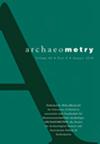利用 Kohonen 自组织地图对碎片陶器进行分类(乌克兰东部 Hlyboke Ozero-2 定居点的案例研究)
IF 1.5
3区 地球科学
0 ARCHAEOLOGY
引用次数: 0
摘要
本文专门测试了以椭圆傅里叶系数为定量变量的 Kohonen 自组织图,以完成对破碎和非标准化陶瓷进行形态分类的任务。所使用方法的优势在于它能够考虑到数据集中固有的系统统计关系,建立不同程度的概括模型,并将多元数据可视化。该方法在乌克兰东部 Hlyboke Ozero-2 定居点的材料上得到了验证。结果与使用主成分分析 + k-means 聚类法得出的结果进行了比较。本文章由计算机程序翻译,如有差异,请以英文原文为准。
Classification of fragmented pottery with the use of Kohonen self-organising maps (case study from the Hlyboke Ozero-2 settlement in Eastern Ukraine)
The paper is devoted to testing Kohonen self-organising maps, with elliptic Fourier coefficients as quantitative variables, for the task of morphological classification of fragmented and non-standardised ceramics. The advantage of the methodology used is its ability to account for the systematic statistical relationships inherent in the dataset, build models of varying degrees of generalisation and visualise multivariate data. The approbation of the method was carried out on materials from the Hlyboke Ozero-2 settlement in Eastern Ukraine. The results are compared with the results obtained using principal component analysis + k-means clustering.
求助全文
通过发布文献求助,成功后即可免费获取论文全文。
去求助
来源期刊

Archaeometry
地学-地球科学综合
CiteScore
3.60
自引率
12.50%
发文量
105
审稿时长
6 months
期刊介绍:
Archaeometry is an international research journal covering the application of the physical and biological sciences to archaeology, anthropology and art history. Topics covered include dating methods, artifact studies, mathematical methods, remote sensing techniques, conservation science, environmental reconstruction, biological anthropology and archaeological theory. Papers are expected to have a clear archaeological, anthropological or art historical context, be of the highest scientific standards, and to present data of international relevance.
The journal is published on behalf of the Research Laboratory for Archaeology and the History of Art, Oxford University, in association with Gesellschaft für Naturwissenschaftliche Archäologie, ARCHAEOMETRIE, the Society for Archaeological Sciences (SAS), and Associazione Italian di Archeometria.
 求助内容:
求助内容: 应助结果提醒方式:
应助结果提醒方式:


